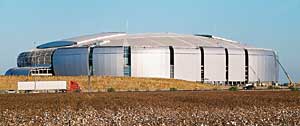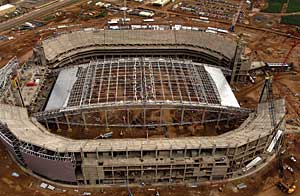Stadium Roofs Offer Much More Than Shelter
Raising the roof
Because Calatrava began with an existing facility, design and construction of the roof was the primary construction project at the Athens Olympics Stadium. But even with entirely new facilities, the complexity of the long-span structures that top them sometimes drives the whole construction sequence. At the $450 million stadium for the National Football League's Arizona Cardinals under construction in Glendale and on track for completion in time for a preseason game with the Pittsburgh Steelers on August 12, "the roof structure dictated the way things were to be built," says Robert Aylesworth, Jr., executive vice president for Hunt Construction Group, the project's design-build contractor.
The 63,000-seat stadium, designed by Eisenman Architects with HOK Sport, is clad in insulated steel panels to resemble a barrel cactus. It has an operable roof and the first field in North America to roll out of one end of the stadium on a 44-foot-long, 230-foot-wide, and 40-inch-deep "cake tray." This arrangement will ensure sufficient sunlight for the natural turf and also provides a floor surface suitable for events like conventions and concerts. According to the owner, the roll-out field was about $50 million less than a retractable roof with a large enough opening to allow necessary sunshine to reach the turf.
|
The 5,400-ton roof assembly was built on the ground and, over the course of several days, jacked 120 feet in the air to its final position on top of four corner-reinforced concrete supercolumns, each 20 feet by 17 feet in plan. The motivation for building the 5,400-ton roof assembly on the ground was primarily worker safety, says David Schuff, chairman of the project's steel fabricator and erector, Schuff International.
The process also saved time and money. Crews began building the roof in August 2004 and lifted it seven months later. The contractor estimates that avoiding the use of shoring and multiple lifts shaved 10 weeks off the construction schedule and saved about $2.5 million. "If we built it in the air, we would still be out there with shoring," says Schuff.











